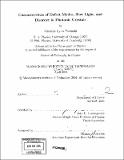| dc.contributor.advisor | John D. Joannopoulos. | en_US |
| dc.contributor.author | Povinelli, Michelle Lynn, 1975- | en_US |
| dc.contributor.other | Massachusetts Institute of Technology. Dept. of Physics. | en_US |
| dc.date.accessioned | 2005-10-14T20:36:59Z | |
| dc.date.available | 2005-10-14T20:36:59Z | |
| dc.date.copyright | 2004 | en_US |
| dc.date.issued | 2004 | en_US |
| dc.identifier.uri | http://hdl.handle.net/1721.1/29449 | |
| dc.description | Thesis (Ph. D.)--Massachusetts Institute of Technology, Dept. of Physics, 2004. | en_US |
| dc.description | Includes bibliographical references (p. 97-122). | en_US |
| dc.description.abstract | Chapter 1 introduces the subject of photonic crystals and reviews the basic physical principles underlying the formation of a band gap and the creation of localized defect modes. Proposed applications, fabrication techniques, and numerical simulation methods are surveyed. Chapter 2 demonstrates the construction of 2D-like defect modes in a 3D photonic crystal with a complete gap. The modes are similar to those in 2D photonic crystals in terms of polarization, field profile, and projected band structures. The results should facilitate the implementation of 2D photonic-crystal devices in realistic 3D systems. Chapter 3 explores the possibility of using photonic-crystal defect modes to design magnetic metamaterials: structures that exhibit magnetic properties despite the non- magnetic character of their constituents. A synthetic magnetic moment is provided by a point-defect mode studied in Chapter 2. Quantitative analysis of the far-field radiation pattern proves that the mode has a primarily magnetic character: over 98% of the emitted power goes into magnetic multipole radiation. Chapter 4 calculates the radiation pressure on the surface of a waveguide formed by ornnidirectionally reflecting mirrors. In the absence of losses, the pressure goes to infinity as the distance between the mirrors is reduced to the cutoff separation of the waveguide mode. The divergence results from the reduction of the modal group velocity to zero, which causes slow-light magnification of the field intensity at constant power input. | en_US |
| dc.description.abstract | (cont.) Chapter 5 analyzes slow-light, band-edge waveguides for compact, integrated, tun- able optical time delays. Slow group velocities at the photonic band edge give rise to large changes in time delay for small changes in refractive index, shrinking device size. Figures of merit are defined for tuning sensitivity and signal dispersion. Exact calculations for a realistic, three-dimensional grating structure are shown to be well predicted by a simple quadratic-band model, simplifying device design. Chapter 6 derives a general, coupled-mode theory for disorder-induced scattering in strongly periodic systems. The analytical results allow the comparison of photonic- crystal waveguides to similar index-guided waveguides. In the realistic limit of weak disorder, reflections are identical while transmission is higher for the photonic-crystal waveguide. The general results, verified by direct numerical simulations in an example system, suggest a new mechanism for the design of low-loss waveguides. | en_US |
| dc.description.statementofresponsibility | by Michelle Lynn Povinelli. | en_US |
| dc.format.extent | 122 p. | en_US |
| dc.format.extent | 4862658 bytes | |
| dc.format.extent | 4862464 bytes | |
| dc.format.mimetype | application/pdf | |
| dc.format.mimetype | application/pdf | |
| dc.language.iso | eng | en_US |
| dc.publisher | Massachusetts Institute of Technology | en_US |
| dc.rights | M.I.T. theses are protected by copyright. They may be viewed from this source for any purpose, but reproduction or distribution in any format is prohibited without written permission. See provided URL for inquiries about permission. | en_US |
| dc.rights.uri | http://dspace.mit.edu/handle/1721.1/7582 | |
| dc.subject | Physics. | en_US |
| dc.title | Characteristics of defect modes, slow light, and disorder in photonic crystals | en_US |
| dc.type | Thesis | en_US |
| dc.description.degree | Ph.D. | en_US |
| dc.contributor.department | Massachusetts Institute of Technology. Department of Physics | |
| dc.identifier.oclc | 56210647 | en_US |
